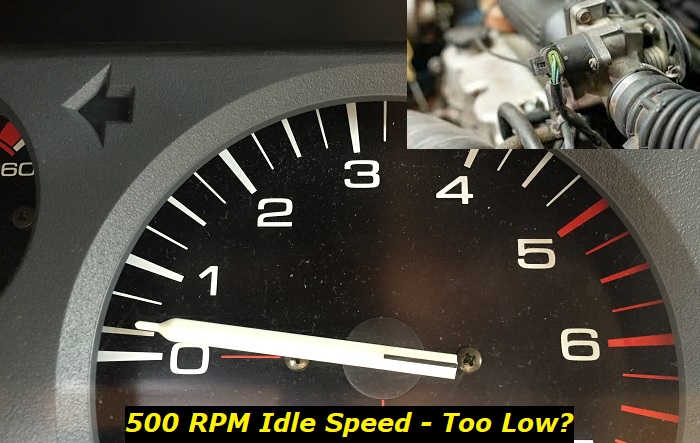There could be an engine or transmission problem if your car is idling at 500 RPM. It should rather be idling around 600-1,000, depending on the vehicle make and model year. That's a possible half of the required engine speed missing! Read further to discover the reasons for low or incorrect RPM idle.
Electrical problems leading to RPM anomalies highlights
- DIY repairs:possible but complicated
- Tools needed:inspection and repair tools
- Commonreasons:idle control valve, throttle position sensor, wiring, software
- Time to repair:1 - 2.5 hours
- Price for parts:$50 - $300
- Can you drive?Yes
- Alternative solutions:unplugging sensors, resetting or relearning sensors

Various factors affect idle speed; including altitude, temperature, and fuel type. An engine that's idling too low can cause stalling when the car is stopped or unusual vibrations. On the other hand, high idling could result in a change in engine sound and unnecessary revving. There might be vibrations as well.
1) Standard Idle RPM
Check your vehicle owner's manual for the stipulated RPM, since it has been established that a normal idle speed should be between 600 RPMs and 1,000 RPMs. Every vehicle model has its own specific RPM or idle speed range that's regarded as normal.
The gauge that shows an engine's RPMs is called a tachometer and it's typically found close to the speedometer. You'll notice the gauge going higher when accelerating, while it will be going lower when you reduce the car's speed.
Tachometers are labeled with single-digit numbers. The gauge typically begins at 1 and increases from there. The numbers are to be multiplied by 1,000 to interpret the reading. So it'll mean 2,000 RPMs when you see that the indicator is at "2".
Watch for erratic fluctuations on the tachometer and try to figure out what's wrong when such happens. You should be worried if the RPM surpasses the 1,000-RPM mark. This is because most cars should be able to idle below this limit.
There might be an engine issue if the system needs to idle at a rate higher than 1,000 just to run smoothly. For example, a mechanical defect. The same goes for when it's idling below 600. You may have to perform a vehicle tune-up to resolve the issue.
Your engine could possibly hit 2,000 RPMs. But this should only be considered normal when you first start a sports, luxury, or high-performance car. It could be between 1,000 and 2,000 at first, but the vehicle will adjust to lower numbers after it has warmed up.
Then there's that of a regular car that might begin with an RPM between 700 and 1,000. It will slowly adjust to a range of 600 to 850 after warming up.
2) Idle RPM in Manual Transmission Systems and Automatic Transmission Systems
Idle RPM in cars that feature manual transmissions entails the standard engine speed that's recommended for the vehicle when the transmission is in neutral or the clutch is engaged.
On the other hand, idle RPM in cars with automatic transmissions means the standard engine speed when the transmission is in park or neutral.
Reasons for Idle Problems
You would suspect that something is wrong with your engine idle when certain signs manifest. For example; the check engine light (CEL) alert, non-standard RPMs, jumpy acceleration, car stalling, sputtering, shuddering, etc. See the possible reasons for idle issues below.
1) Vacuum Leak
A vacuum leak can cause the engine to idle at irregular speeds because of the stress on the system. The CEL may come on in this case.
2) Bad Spark Plugs
Spark plugs are instrumental to the ignition system and they can get bad or dirty after a long time frame of use. Routine replacement of the plugs is required to avoid this situation, or else the engine speed could be abnormal and the car might start stalling.
3) Dirty/Clogged Air Filter
The air filter of your car blocks insects, debris, sand, dust, and other particles from getting into the engine. It also helps in the maintenance of the proper air-fuel ratio needed for optimal vehicle performance. So imagine that this part develops a defect. Engine speed will be odd.
4) Defective/Dirty Throttle Position Sensor
The throttle position sensor is responsible for tracking an engine's air intake. So a fault would hurt the air-fuel ratio and then the idle speed.
5) Failing/Stuck Idle Air Control (IAC) Actuator or Valve
This component has to be in good working condition for RPMs to be at the standard rate. It can get defective when carbon accumulates on it or the fuse associated with its power supply gets shorted. Rough idling could occur after.
6) Bad Engine Computer or Control Module
The engine's control unit keeps track of all the sensors connected to it and maintains balance in the system. A malfunction of the computer would make the components start misbehaving, including those associated with engine idle. You'd have to reprogram the module.
Checking the Reasons for Idling Issues
This section describes how you can resolve the problems of low and high engine speed. The best step to take is usually to have a mechanic look at your ASAP. But the following tips might help as well for DIY procedures.
1) When Your Engine Is Idling Too Low
Solution 1: Adjust the Idle Speed Screw
Try to adjust the idle speed screw which is situated on the throttle body. This screw regulates the amount of air flowing into the engine. Turn it anticlockwise to enhance the RPMs.
Solution 2: Examine the Throttle Position Sensor
The throttle position sensor is typically situated on the butterfly shaft/spindle so that it will easily follow the throttle's position. Your engine can idle low when this sensor isn't functioning well.
Inspect this part by unplugging the connector and observing any change in the idle. You'll need to swap out the sensor if any change is noticed.
Solution 3: Check for Vacuum Leaks
Check for vacuum leaks by visual inspection or spraying a soap and water solution from a spray bottle. The solution should be applied to all the possible areas where leakages may be taking place. For example; the hoses, gaskets, connectors, bolts, etc.
A sign of a leak could be a hissing or whistling sound coming from anywhere around the area because of the water and soap spray. Bubbles should be visible at the spots where the sounds are coming from. You could also look out for tears and cracks in the hoses, gaskets, or connectors.
Utilize safety glasses when doing this, and avoid touching moving parts or areas that could be heated. Keep flammable items away as well.
Replace all the components that have leakages, or tighten loosened bolts if that's what it takes to stop the leak. For example, a throttle body mounting bolt.
2) When Your Engine Is Too High
Solution 1: Air Filter Assessment
A clogged or dirty air filter can make your engine hit higher RPMs than it should. You can't overlook it when carrying out physical examinations. Check it for blockages, dirt, or damage.
Solution 2: Look for Vacuum Leaks
You should do this just the way it was explained under the fixes for the idle speed being too low. Leakages around the vacuum area can make your engine run lean, bringing about higher idle speeds. A lean-running engine means that there's an inadequacy of fuel in comparison to air quantity in the engine.
Solution 3: Check the Idle Speed Screw Adjustment
Do the reverse of what was explained under the fixes for the RPM being too low. Rotate the screw clockwise to lower the RPMs.
Conclusion
Many misconceptions about idling have made their way to the internet. And such falsehoods can cause unsuspecting readers to make bad decisions when using their cars. Hopefully, this guide helped clear the air about some confusing aspects of engine idle.
About the authors
The CarAraC research team is composed of seasoned auto mechanics and automotive industry professionals, including individuals with advanced degrees and certifications in their field. Our team members boast prestigious credentials, reflecting their extensive knowledge and skills. These qualifications include: IMI: Institute of the Motor Industry, ASE-Certified Master Automobile Technicians; Coventry University, Graduate of MA in Automotive Journalism; Politecnico di Torino, Italy, MS Automotive Engineering; Ss. Cyril and Methodius University in Skopje, Mechanical University in Skopje; TOC Automotive College; DHA Suffa University, Department of Mechanical Engineering





Add comment